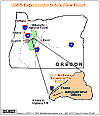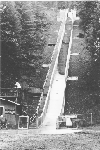|
Debris flows are churning, water-saturated masses of
rock, soil, and organic matter that rush down mountain
slopes. They typically originate as landslides and course
down stream channels when they reach the valley floor,
leaving lobate deposits of debris in their wake. Debris flows
commonly include 60 to 70 percent solid particles by volume
and attain speeds greater than 10 meters per second (22 miles
per hour). As a consequence, debris flows can denude
slopes, damage structures, drastically alter streams, and
occasionally cause loss of human life. ...
Scientific understanding of debris flows has been
hampered by their unpredictable timing, location and
magnitude, which make systematic observation and
measurement of natural events both difficult and dangerous.
Consequently, in 1991 the U.S. Geological Survey (USGS),
in cooperation with the U.S. Forest Service, constructed a
flume to conduct controlled experiments on debris flows.
Located about 45 miles east of Eugene, Oregon, in the Cascades
Range foothills near the headquarters of the H.J. Andrews
Experimental Forest, Blue River Ranger District, Willamette
National Forest, this unique facility provides research
opportunities available nowhere else.
-- Iverson, et.al., 1992
|
 [Map,16K,InlineGIF]
[Map,16K,InlineGIF]
 [Image,271K,GIF]
[Image,271K,GIF]

